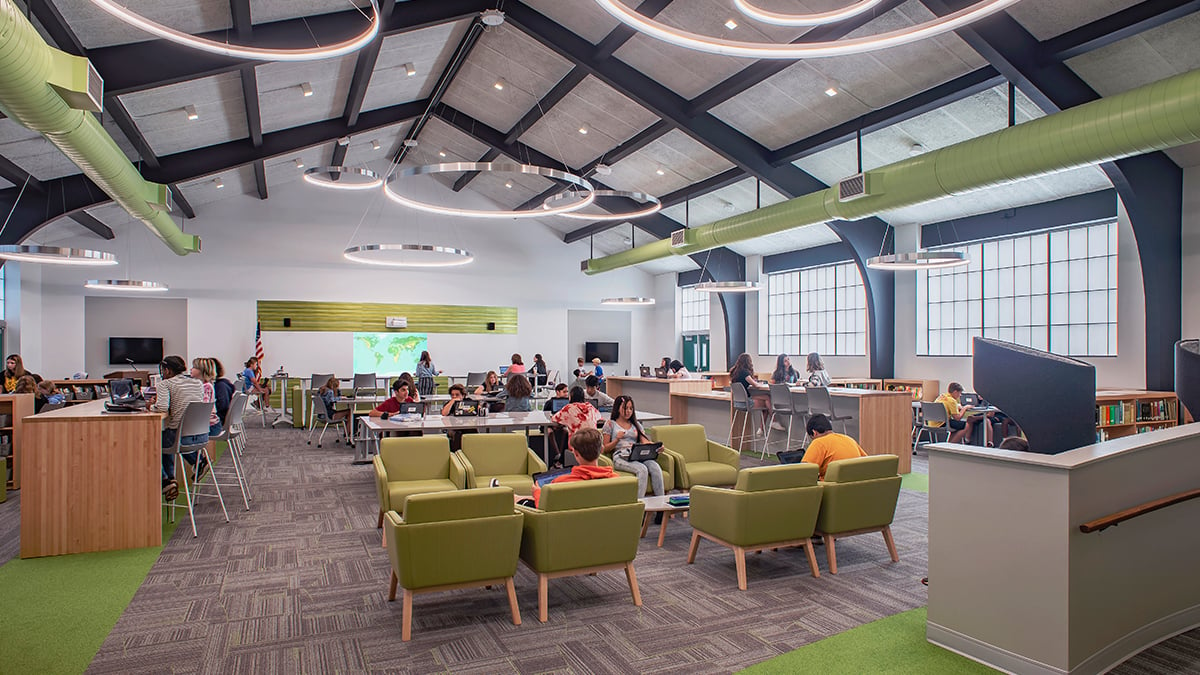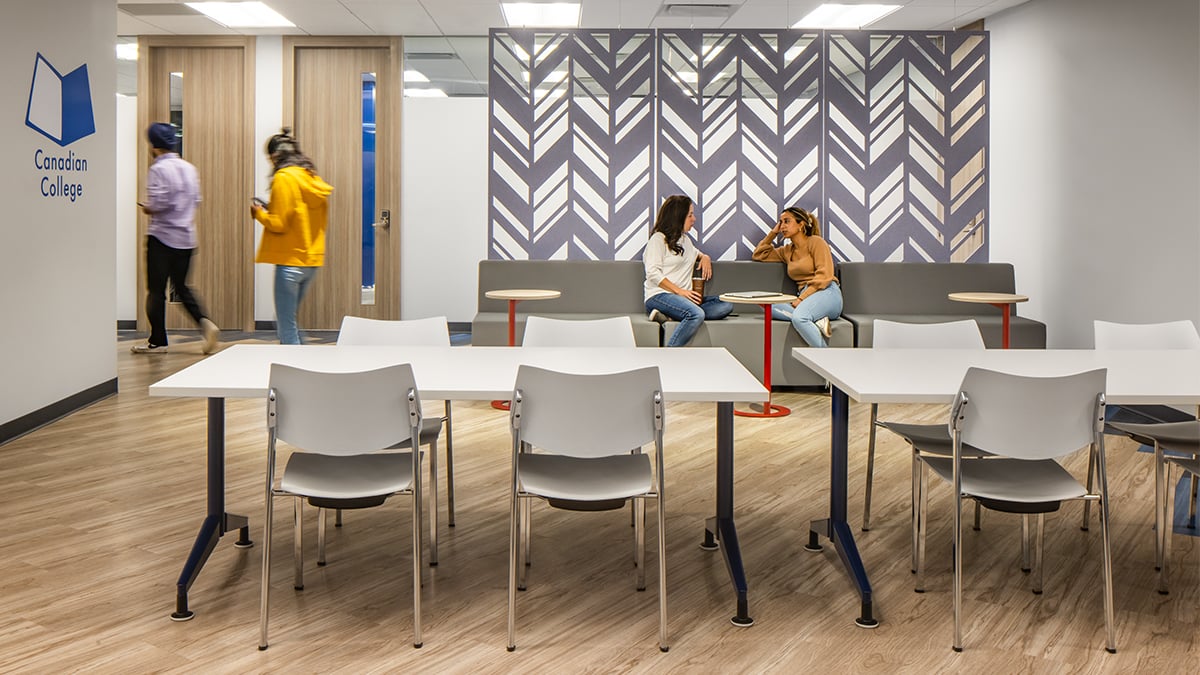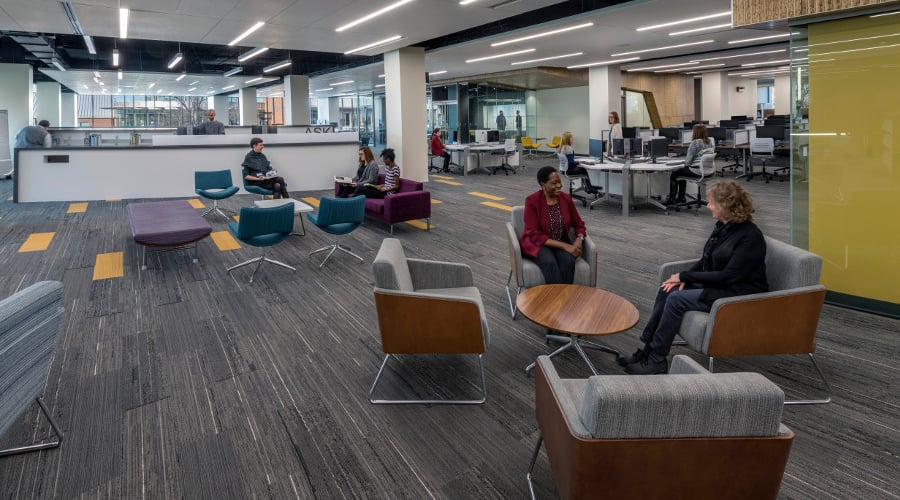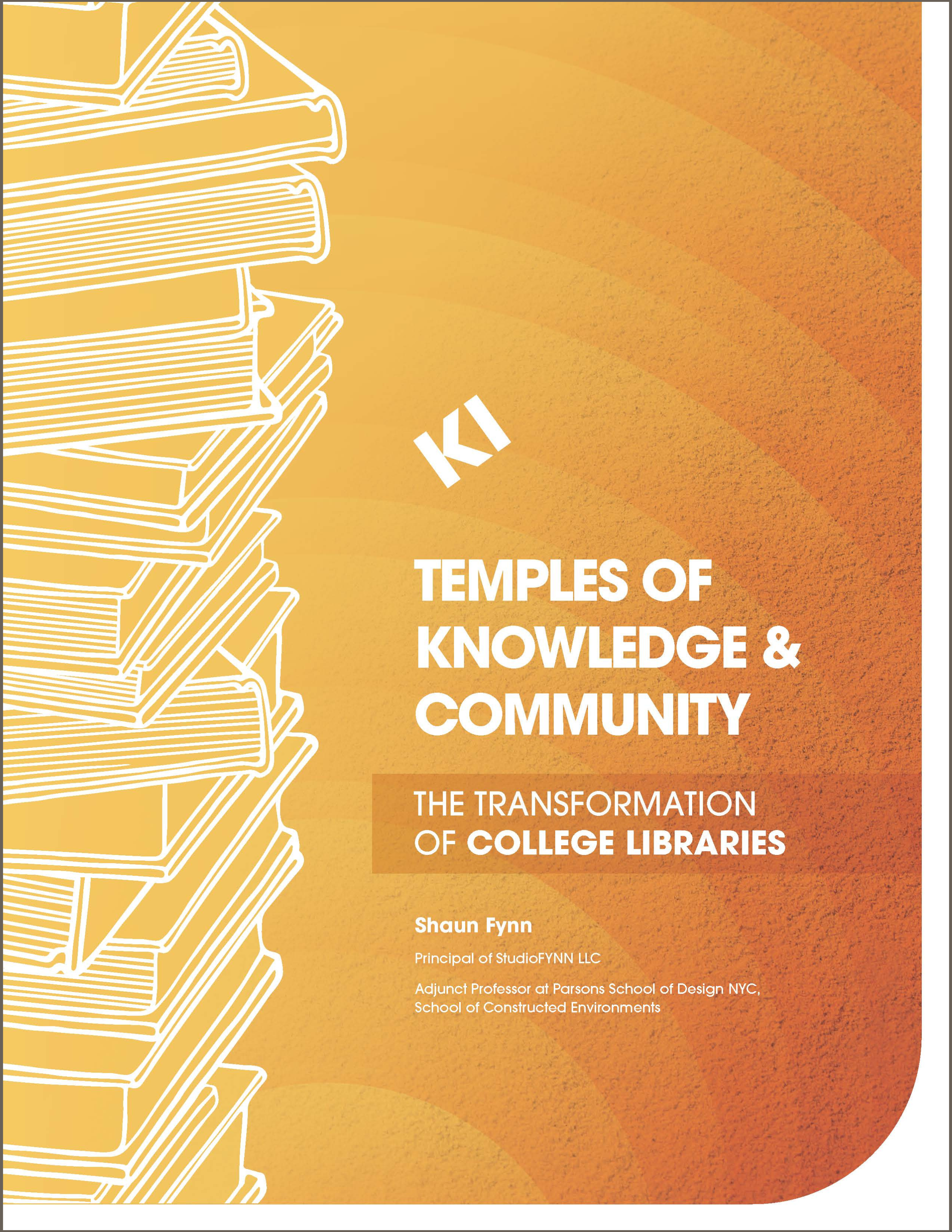- What's New
- Pricing & Purchasing
- Lead Times
- Literature & Samples
- Services & Warranties
- Careers
- Find a Rep
Designing Better College Library Spaces: Leveraging 8 Key Shifts

Transform the design of your college libraries with insights from our latest research highlighting eight key shifts in campus community and innovation.
In the digital age, where information is readily accessible at our fingertips, college libraries are no longer just repositories of books and manuscripts. They are evolving into dynamic spaces that foster collaboration, community, and innovation.
As higher education institutions undergo profound transformations, libraries are at the forefront of redefining their roles as ‘temples of knowledge’ and community hubs.
To understand and navigate these shifts effectively, we partnered with StudioFYNN on extensive research from leading universities across the nation, delving deep into the changing landscape of college libraries. Our research identified eight key shifts that you can leverage to maximize the design of your college library spaces.
This research was made possible by the support and participation of the following institutions: University of Pennsylvania's Integrated Product Design Program, California College of the Arts, Clemson University, CUNY Baruch, Dartmouth College, The New School's Parsons School of Design, and University of California – Berkeley.
Key Shifts in College Library Design
1. Architectural Statement
Designing college library spaces begins with considering the architectural envelope. While new builds offer opportunities for tailored design, existing spaces can be repurposed to accommodate digital resources and collaborative zones. By optimizing architectural features, such as natural lighting and spatial layout, designers can create inviting and functional environments that support diverse learning activities.
2. Post-Build Adaptations
Adapting existing spaces is a common scenario in college library design. Human-centered design principles guide the selection of furniture and interior elements that align with the institution's culture and user needs. Custom-built solutions may be required to address specific spatial challenges and enhance user experience. From ergonomic seating to flexible workstations, every element should contribute to the overall functionality and aesthetic appeal of the library space.
3. Core Spaces Redefined
Traditionally, classrooms were considered the core spaces of higher education institutions. However, college libraries are increasingly fulfilling this role as hubs for collaborative learning and personal growth. Design strategies should prioritize creating versatile environments that accommodate individual study, group projects, and relaxation. By incorporating elements that promote well-being and belonging we can enhance the library's role as a vital learning resource and foster a conducive environment for student success.
4. Signature Space & Brand Projection
College libraries serve as iconic spaces that reflect the institution's brand and values. Furniture selection, spatial layout, and so much more contribute to shaping the library's identity and atmosphere to feel collegiate and welcoming. By creating signature spaces that evoke a sense of pride and belonging, the university’s brand is strengthened and also attracts students, faculty, and alumni. Thoughtful integration of branding elements ensures a cohesive and memorable experience for all library users.
5. Balancing 'Me' And 'We' Spaces
Effective college library design requires striking a balance between individual study areas and collaborative zones. By delineating space according to user preferences and activities, environments can cater to diverse learning styles. Flexible furniture solutions, such as modular lounge seating and movable partitions, enable seamless transitions between 'me' and 'we' spaces, fostering a dynamic and adaptable learning environment.
6. Honoring Tradition While Embracing Innovation
Many college libraries boast rich histories and architectural heritage. Space design should pay homage to these traditions while embracing innovative trends and technologies. By seamlessly integrating traditional elements with modern amenities, designers can create timeless spaces that resonate with both past and present. Thoughtful preservation of historical artifacts and furnishings adds character and authenticity to the library environment.
7. Community-Centric Service Models
Librarians play a crucial role in shaping the community and service offerings of college libraries. Design should facilitate collaboration and interaction between librarians and users, fostering a sense of community and belonging. Incorporating flexible workspaces and technology-enabled service points enhances accessibility and promotes active engagement. By involving librarians in the design process, designers can create spaces that meet the evolving needs of library users.
8. Catering to Diverse Usage Scenarios
Understanding the varied usage patterns of college library spaces is essential for effective design. Designers should consider the duration and intensity of user activities when selecting furniture and layout options. From dedicated study carrels to flexible lounge areas, every space should be optimized to accommodate different usage scenarios. By providing a range of seating options and amenities, designers can create inclusive environments that cater to the diverse needs of library patrons.
Designing Temples of Knowledge & Community
College libraries are in the midst of significant change, driven by technological advancements, evolving pedagogies, and shifting user expectations. By leveraging these eight shifts in the library landscape, interior designers, educators, and others can create dynamic and inclusive environments for ‘temples of knowledge’ that foster collaboration, community, and innovation in college campus libraries.
From signature spaces to community-centric service models, each shift offers valuable insights for optimizing the interior design of college libraries, ensuring they remain vibrant and relevant hubs of learning and connection.
Read our full white paper to learn more about the transformation of college libraries and how to design your own ‘temple of knowledge’ and community.
Stay tuned! This is the first installation of our deep dive into higher education libraries. Additional insights to come.
 Blog
Blog
Libraries provide students of all ages with a place for discovery and exploration. Here are six of our best tips for creating a school library tailored to your students’ needs.
 Blog
Blog
From financial aid to fluctuating enrollment, discover the critical changes and challenges impacting higher education this academic year.
 Blog
Blog
Harper College Library worked with KI to create innovative collaborative study areas and workspaces for students and staff.
Subscribe
Stay up to date with the latest trends and more.















